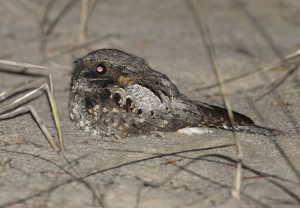
An early Eastern Whip-poor-will on April 21. Photo by Chris Neri
The current weather pattern has really slowed things down the last couple of nights, but prior to that the nights had continued to be productive. Since our last post we have banded 179 owls and recaptured four more previously banded owls. The Northern Saw-whet Owl numbers have, as expected, dropped off since they likely peaked for the season prior to our last post. On the other hand, the Long-eared Owl migration has continued to go strong. The 179 new owls were comprised of 76 Saw-whets, one Boreal and 102 Long-eareds. This brings the season’s total to date up to 678 total owls banded; 475 Saw-whets, two Boreals, 196 Long-eareds, four Barreds and one Great Horned. Among the recent recaptures was a Barred Owl banded here last fall by Keegan Tranquillo and Raina Milnes. Another of the recaptures was a Saw-whet banded as a hatch year bird in Minnesota in the fall of 2010, so she will soon be turning seven years old.
The Saw-whet total is at this point lower than some of the big totals we have experienced in the past, but is rebounding nicely from the unexpectedly low totals we had the last three springs. As was the case last spring, the Long-eared total this spring is very significant. During my first season at WPBO in the spring of 1999 we banded 176 Long-eareds. I didn’t realize it at the time, but this was not only a record high for WPBO, but a record for any North American banding station. Last spring we banded 336 Long-eareds, nearly doubling that record which stood for 15 years. We will be surprised if we surpass last spring’s total, but regardless, this season’s total already represents the second highest North American banding total. As a result, WPBO now holds the three highest totals for Long-eared Owls!
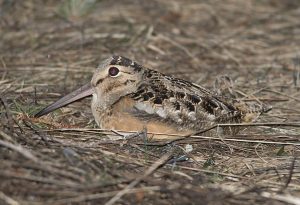
American Woodcock roosting in the net lanes. Photo by Chris Neri
We regularly see American Woodcocks in the net lanes at night and hear the males preforming their courtship flights in the evenings and at dawn. It is not uncommon for us to catch a few and they are really amazing to experience up close. They have some pretty incredible adaptations that we love having the opportunity too see. They feed by probing into mud with their bills. To help them avoid being preyed upon while feeding, their eyes are placed so that they actually have binocular vision to the back of their head so that they can spot predators behind them.
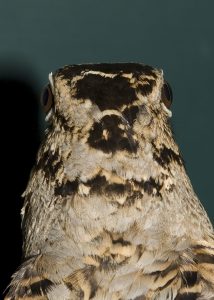
A view of a Woodcock’s eyes from the back of its head.
We also always enjoy hearing the sounds of the male’s courtship flight. They get high in the air and spiral down while making a twittering sound. This is not a vocalization, but is produced by air passing through its specialized three outermost primary flight feathers. As you can see in the photo below, these three feathers are very thin and are used to produce the twittering sound in flight. The male then lands on the ground and gives his “peent” call.
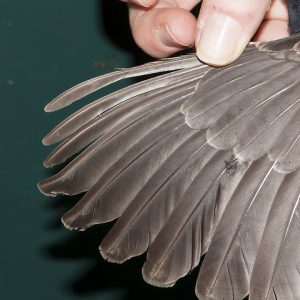
The male Woodcock’s thin outermost primaries that produce the twittering sounds during its courtship flight.
Chris Neri & Nova Mackentley



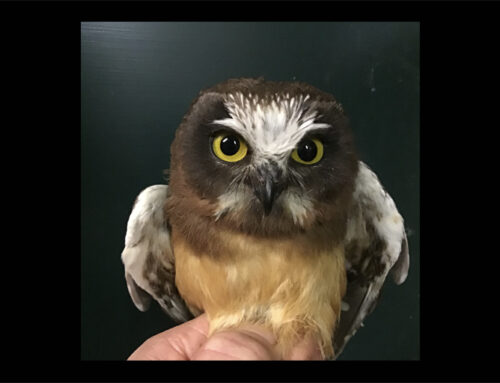
Hi Chris,
I was just thinking about you guys, as my Facebook memories this week are reminding me that I was at Whitefish point this week in 2009 for migration.
And apparently, myself and my birding roadtrip partner Dug banded some owls with you the night of May 7 into May 8th.
We didn’t catch much as the weather wasn’t perfect, but, it was and still is to me, one of the most amazing experiences that I’ve ever had.
I don’t admit to many, but I did actually cry that night as I thought about that beautiful little female sawhet. I was amazed at how calm she was. Having already at that time been a vet tech for over 10 years, I know that domestic animals are always the ones to try to take your faces off. And anytime I’ve ever worked with wildlife, they’ve always been so calm.
Anyway, I was just wondering, if there’s anyway to go into the info for that night ? Have you ever recaptured those owls?
I tried to keep up with the blog over the years but I moved back to NY and my career changed from animals to law enforcement and then a life with a kid and sadly my hobby comes last.
Any help at all would be appreciated.
You get to go out there and see those amazing birds, and the rest of us live vicariously through you.
Please let me know.
Thanks,
Jennifer
Jayklvt@gmail